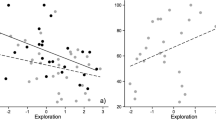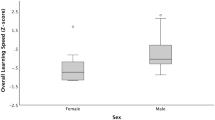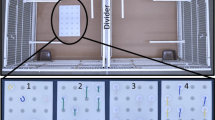Abstract
Cognitive processes are important to animals because they not only influence how animals acquire, store and recall information, but also may underpin behaviours such as deciding where to look for food, build a nest, or with whom to mate. Several recent studies have begun to examine the potential interaction between variation in cognition and variation in personality traits. One hypothesis proposed that there is a speed–accuracy trade-off in cognition ability that aligns with a fast–slow behaviour type. Here, we explicitly examined this hypothesis by testing wild-caught black-capped chickadees in a series of cognitive tasks that assessed both learning speed (the number of trials taken to learn) and accuracy (post-acquisition performance when tested with un-trained exemplars). Chickadees’ exploration scores were measured in a novel environment task. We found that slow-exploring chickadees demonstrated higher accuracy during the test phase, but did not learn the initial task in fewer trials compared to fast-exploring chickadees, providing partial support for the proposed link between cognition and personality. We report positive correlations in learning speed between different phases within cognitive tasks, but not between the three cognitive tasks suggesting independence in underlying cognitive processing. We discuss different rule-based strategies that may contribute to differential performance accuracy in cognitive tasks and provide suggestions for future experimentation to examine mechanisms underlying the relationship between cognition and personality.





Similar content being viewed by others
References
Amy M, van Oers K, Naguib M (2012) Worms under cover: relationships between performance in learning tasks and personality in great tits (Parus major). Anim Cogn 5:763–770. doi:10.1007/s10071-012-0500-3
Bell AM, Foster SA, Wund M (2013) Evolutionary perspectives on personality in stickleback fish. In: Carere C, Maestripieri D (eds) Animal personalities: behavior physiology and evolution. The University of Chicago Press, Chicago, pp 36–65
Biro PA, Dingemanse NJ (2010) Sampling bias resulting from animal personality. Trends Ecol Evol 24:66–67. doi:10.1016/j.tree.2008.10.004
Bloomfield TM (1967) A peak shift on a line tilt continuum. J Exp Anal Behav 4:361–366
Boogert NJ, Reader S, Laland KN (2006) The relation between social rank, neophobia and individual learning in starlings. Anim Behav 1229–1239. doi:10.1016/j.anbehav.2006.02.021
Boogert NJ, Giraldeau L-A, Lefebvre L (2008) Song complexity correlates with learning ability in zebra finch males. Anim Behav 76:1735–1741. doi:10.1016/j.anbehav.2008.08.009
Boogert NJ, Anderson RC, Peters S et al (2011) Song repertoire size in male song sparrows correlates with detour reaching, but not with other cognitive measures. Anim Behav 81:1209–1216. doi:10.1016/j.anbehav.2011.03.004
Bouchard J, Goodyer W, Lefebvre L (2007) Social learning and innovation are positively correlated in pigeons (Columba livia). Anim Cogn 10:259–266. doi:10.1007/s10071-006-0064-1
Brust V, Wuerz Y, Krüger O (2013) Behavioural flexibility and personality in zebra finches. Ethology 119. doi:10.1111/eth.12095
Budaev SV, Zhuikov AY (1998) Avoidance learning and “personality” in the guppy (Poecilia reticulata). J Comp Psychol 112:92–94
Carere C, Locurto C (2011) Interaction between animal personality and animal cognition. Curr Zool 57:491–498
Carere C, Caramaschi D, Fawcett TW (2010) Covariation between personalities and individual differences in coping with stress: converging evidence and hypotheses. Curr Zool 56:728–740
Charrier I, Bloomfield LL, Sturdy CB (2004) Note types and coding in parid vocalizations. I: the chick-a-dee call of the black-capped chickadee (Poecile atricapillus). Can J Zool 779:769–779. doi:10.1139/Z04-045
Charrier I, Lee TT, Bloomfield LL, Sturdy CB (2005) Acoustic mechanisms of note-type perception in black-capped chickadee (Poecile atricapillus) calls. J Comp Psychol 119:371–380. doi:10.1037/0735-7036.119.4.371
Chittka L, Skorupski P, Raine NE (2009) Speed-accuracy tradeoffs in animal decision making. Trends Ecol Evol 24:400–407. doi:10.1016/j.tree.2009.02.010
Cockrem JF (2007) Stress, corticosterone responses and avian personalities. J für Ornithol 148:169–178. doi:10.1007/s10336-007-0175-8
Cole EF, Quinn JL (2012) Personality and problem-solving performance explain competitive ability in the wild. Proc Biol Sci 279:1168–1175. doi:10.1098/rspb.2011.1539
Cole EF, Cram DL, Quinn JL (2011) Individual variation in spontaneous problem-solving performance among wild great tits. Anim Behav 81:491–498. doi:10.1016/j.anbehav.2010.11.025
Cole EF, Morand-Ferron J, Hinks AE, Quinn JL (2012) Cognitive ability influences reproductive life history variation in the wild. Curr Biol 22:1808–1812. doi:10.1016/j.cub.2012.07.051
Coppens CM, de Boer SF, Koolhaas JM (2010) Coping styles and behavioural flexibility: towards underlying mechanisms. Philos Trans R Soc B Biol Sci 365:4021–4028. doi:10.1098/rstb.2010.0217
Dingemanse NJ, de Goede P (2004) The relation between dominance and exploratory behavior is context-dependent in wild great tits. Behav Ecol 15:1023–1030. doi:10.1093/beheco/arh115
Dingemanse NJ, Both C, van Noordwijk AJ et al (2003) Natal dispersal and personalities in great tits (Parus major). Proc R Soc B Biol Sci 270:741–747. doi:10.1098/rspb.2002.2300
Dingemanse NJ, Both C, Drent PJ, Tinbergen JM (2004) Fitness consequences of avian personalities in a fluctuating environment. Proc R Soc B Biol Sci 271:847–852. doi:10.1098/rspb.2004.2680
Drent PJ, van Oers K, Van Noordwijk AJ (2003) Realized heritability of personalities in the great tit (Parus major). Proc R Soc B Biol Sci 270:45–51. doi:10.1098/rspb.2002.2168
Dugatkin LA, Alfieri MS (2003) Boldness, behavioral inhibition and learning. Ethol Ecol Evol 15:43–49
Exnerová A, Svádová KH, Fucíková E et al (2010) Personality matters: individual variation in reactions of naive bird predators to aposematic prey. Proc R Soc B Biol Sci 723–728. doi:10.1098/rspb.2009.1673
Federation of Alberta Naturalists (2007) Black-capped chickadee (Poecile atricapillus). Atlas breed. Birds Alberta a second look. Federation of Alberta Naturalists, Altona, pp 387–391
Galsworthy MJ, Paya-Cano JL, Liu L et al (2005) Assessing reliability, heritability and general cognitive ability in a battery of cognitive tasks for laboratory mice. Behav Genet 35:675–692. doi:10.1007/s10519-005-3423-9
Groothuis TGG, Carere C (2005) Avian personalities: characterization and epigenesis. Biobehav Rev 29:137–150. doi:10.1016/j.neubiorev.2004.06.010
Guenther A, Brust V, Dersen M, Trillmich F (2014) Learning and personality types are related in cavies (Cavia aperea). J Comp Psychol 128:74–81. doi:10.1037/a0033678
Guillette LM, Reddon AR, Hurd PL, Sturdy CB (2009) Exploration of a novel space is associated with individual differences in learning speed in black-capped chickadees, Poecile atricapillus. Behav Process 82:265–270. doi:10.1016/j.beproc.2009.07.005
Guillette LM, Bailey AA, Reddon AR (2010a) A brief report: capture order is repeatable in chickadees. Int J Comp Psychol 9:216–224
Guillette LM, Farrell TM, Hoeschele M et al (2010b) Mechanisms of call note-type perception in black-capped chickadees (Poecile atricapillus): peak shift in a note-type continuum. J Comp Psychol 124:109–115. doi:10.1037/a0017741
Guillette LM, Reddon AR, Hoeschele M, Sturdy CB (2011) Sometimes slower is better: slow-exploring birds are more sensitive to changes in a vocal discrimination task. Proc R Soc B Biol Sci 278:767–773. doi:10.1098/rspb.2010.1669
Hanson HM (1959) Effects of discrimination training on stimulus generalization. J Exp Psychol 58:321–334
Hollander FA, Van Overveld T, Tokka I, Matthysen E (2008) Personality and nest defence in the great tit (Parus major). Ethology 114:405–412. doi:10.1111/j.1439-0310.2008.01488.x
Honig WK, Urcuioli PJ (1981) The legacy of Guttman and Kalish: 25 years of reearch on stimulus generalization. J Exp Anal Behav 3:405–445
Honig WK, Boneau CA, Burstein KR, Pennypacker HS (1963) Positive and negative generalization gradients obtained after equivalent training conditions. J Comp Physiol Psychol 56:111–116. doi:10.1037/h0048683
Keagy J, Savard J-F, Borgia G (2011) Complex relationship between multiple measures of cognitive ability and male mating success in satin bowerbirds, Ptilonorhynchus violaceus. Anim Behav 81:1063–1070. doi:10.1016/j.anbehav.2011.02.018
Koolhaas JM, Korte SM, De Boer SF et al (1999) Coping styles in animals: current status in behavior and stress-physiology. Neurosci Biobehav Rev 23:925–935
Koolhaas JM, de Boer SF, Coppens CM, Buwalda B (2010) Neuroendocrinology of coping styles: towards understanding the biology of individual variation. Front Neuroendocrinol 31:307–321. doi:10.1016/j.yfrne.2010.04.001
Marchetti C, Drent PJ (2000) Individual differences in the use of social information in foraging by captive great tits. Anim Behav 131–140. doi:10.1006/anbe.2000.1443
Matzel LD, Han YR, Grossman H et al (2003) Individual differences in the expression of a “general” learning ability in mice. J Neurosci 23:6423–6433
Naguib M, Kazek A, Schaper SV et al (2010) Singing activity reveals personality traits in great tits. Ethology 116:763–769. doi:10.1111/j.1439-0310.2010.01791.x
Nakagawa S, Gillespie DOS, Hatchwell BJ, Burke T (2007) Predictable males and unpredictable females: sex difference in repeatability of parental care in a wild bird population. J Evol Biol 20:1674–1681. doi:10.1111/j.1420-9101.2007.01403.x
Niemelä PT, Vainikka A, Forsman JT et al (2013) How does variation in the environment and individual cognition explain the existence of consistent behavioral differences? Ecol Evol 3:457–464. doi:10.1002/ece3.451
Pyle P (1997) Identification guide to North American birds. Part 1. Slate Creek Press, Bolinas
Reale D, Reader S, Sol D et al (2007) Integrating animal temperament within ecology and evolution. Biol Rev 82:291–318. doi:10.1111/j.1469-185X.2007.00010.x
Reale D, Dingemanse NJ, Kazem AJ, Wright J (2010) Evolutionary and ecological approaches to the study of personality. Philos Trans R Soc B Biol Sci 365:3937–3946. doi:10.1098/rstb.2010.0222
Schuett W, Dall SRX (2009) Sex differences, social context and personality in zebra finches, Taeniopygia guttata. Anim Behav 77:1041–1050. doi:10.1016/j.anbehav.2008.12.024
Sih A, Del Giudice M (2012) Linking behavioural syndromes and cognition: a behavioural ecology perspective. Philos Trans R Soc B Biol Sci 367:2762–2772. doi:10.1098/rstb.2012.0216
Smith SM (1991) The black-capped chickadee: behavioral ecology and natural history. Comstock/Cornell University Press, Ithica
Sneddon LU (2003) The bold and the shy: individual differences in rainbow trout. J Fish Biol 44:971–975. doi:10.1046/j.1095-8649.2003.00084.x
Sturdy CB, Phillmore LS, Weisman RG (2000) Call-note discriminations in black-capped chickadees (Poecile atricapillus). J Comp Psychol 114:357–364
Sturdy CB, Bloomfield LL, Farrell TM et al (2007) Auditory category perception as a natural cognitive activity in songbirds. Comp Cogn Behav Rev 2:93–110
Tebbich S, Stankewitz S, Teschke I (2011) The relationship between foraging, learning abilities and neophobia in two species of Darwin’s finches. Ethology 135–146. doi:10.1111/j.1439-0310.2011.02001.x
Thornton A, Lukas D (2012) Individual variation in cognitive performance: developmental and evolutionary perspectives. Philos Trans R Soc B Biol Sci 367:2773–2783. doi:10.1098/rstb.2012.0214
Titulaer M, van Oers K, Naguib M (2012) Personality affects learning performance in difficult tasks in a sex-dependent way. Anim Behav 83:723–730. doi:10.1016/j.anbehav.2011.12.020
Van Oers K, Naguib M (2013) Avian personality. In: Carere C, Maestripieri D (eds) Animal personal behavior physiology evolution. The University of Chicago Press, Chicago, pp 66–95
Van Oers K, Drent PJ, Dingemanse NJ, Kempenaers B (2008) Personality is associated with extrapair paternity in great tits, Parus major. Anim Behav 555–563. doi:10.1016/j.anbehav.2008.03.011
Verbeek MEM, Drent PJ, Wiepkema PR (1994) Consistent individual differences in early exploratory behaviour in male great tits. Anim Behav 48:1113–1121
Vlamings PHJM, Hare B, Call J (2010) Reaching around barriers: the performance of the great apes and 3–5-year-old children. Anim Cogn 13:273–285. doi:10.1007/s10071-009-0265-5
Acknowledgments
This work was supported by a Natural Sciences and Engineering Research Council of Canada (NSERC) Discovery Grant (RGPIN 249887) and Discovery Accelerator Supplement (RGPAS 412311), Canada Foundation for Innovation (CFI) New Opportunities Fund and Infrastructure Operating Fund grants, an Alberta Ingenuity New Faculty Grant, and CFI partner funding and start-up funding from the University of Alberta. LMG was supported by an Izaak Walton Killam Memorial Scholarship (IWKMS) at the University of Alberta and is currently a Newton International Fellow supported by the Royal Society and the British Academy. MH was supported by an NSERC PostGraduate Scholarship, an Alberta Ingenuity Graduate Student Scholarship and an IWKMS and is currently funded by a European Research Council advanced Grant [No. 230604 ‘SOMACCA’] awarded to W. Tecumseh Fitch at the University of Vienna. AHH is supported by the Department of Psychology at the University of Alberta. We thank our research assistant John Hoang for aid in running instrumental training, and our technical assistants, Lou Omerzu and Isaac Lank. Thanks to Sue Healy and Andrea Griffin for comments on the discussion and two anonymous reviews for comments on the manuscript.
Author information
Authors and Affiliations
Corresponding author
Electronic supplementary material
Below is the link to the electronic supplementary material.
This video is a successful trial (pass) in the Colour association task. Yellow was the S+, and blue was the S- (MPG 8512 kb)
This video is an unsuccessful trial (fail) in the Colour association task. Red was the S+, and green was the S- (MPG 5976 kb)
This video is a successful trial (pass) in the Colour association task. Yellow was the S+, and blue was the S- (MPG 18054 kb)
This video is an unsuccessful trial (fail) with the transparent tube in the Detour-reaching task (MPG 1788 kb)
This video is a successful trial (pass) with the transparent tube in the Detour-reaching task (MPG 1070 kb)
Rights and permissions
About this article
Cite this article
Guillette, L.M., Hahn, A.H., Hoeschele, M. et al. Individual differences in learning speed, performance accuracy and exploratory behaviour in black-capped chickadees. Anim Cogn 18, 165–178 (2015). https://doi.org/10.1007/s10071-014-0787-3
Received:
Revised:
Accepted:
Published:
Issue Date:
DOI: https://doi.org/10.1007/s10071-014-0787-3




